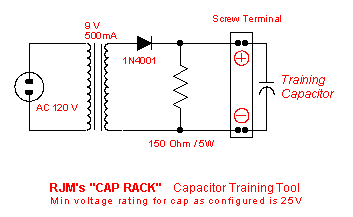The CAP-RACK
Boot Camp for Capacitors-in-Training
Here is an answer to audio capacitors that require an inordinate amount of break-in time before they sound even listenable: the cap-rack!

The concept is to build a device that you can easily plug components in and out of from stuff you probably have lying around already. The cap-rack keeps the capacitors polarized while subjecting them to large charge-discharge cycles. A few days is guarenteed to break in even the most stubborn of exotic capcitors!
Here's my recipe:
|
|
|
You need a small transformer like those found inside any generic power supply. The AC output should be about 9 V, so the innards of a 12V - 14 V, 500 mA power supply would be ideal. Attach an AC cord to the input side of the transformer, being careful to tape or apply heatshrink over any exposed wire. If you scrounged the transformer from a DC power supply, chances are the bridge rectifier diodes are still attached. If so, leave them there; if not, attach a single 1N4001-or-bigger diode on as shown on he circuit. Find a resistor rated at least 2 W, 5 W is better. Anything bewteen 100 and 1000 ohms is fine. Insert across the output as shown. Add a screw terminal strip and mark the positive terminal for easy identification. A large terminal strip can be wired to accept several capacitors at once. Attach the capacitor, plug the transformer into a wall socket and try and forget all about it for a week. Then come back and wire those great sounding, fully broken in capacitors into your audio system! |
I built this device to break in the Black Gate electrolytic capacitors I planned to use in the cathode bypass circuit of my tube amp. The values were 10 µF / 50 V and 100 µF / 50V. Black Gates are the most notorious example I know of components that sound bad until a long break-in time has expired.
In a email, Vincent Siu wrote to me:
The break-in time for the Black Gate capacitor is at least 200 hours and it does depend on how it is being broken-in, continuously or on/off (which takes much longer). The sound of the Black Gate caps before break-in is tight, dry, less dynamic and not musical. The sound will be excellent after broken-in with good dynamics, well controlled bass, neutral and musical sound with dead quiet background.
The only thing I would add to that is my complete agreement. This is exactly what I found. It's been said dozens of times before, but I'll say it again: Don't judge them until you've had them in your system a couple of weeks ... or, less painful for you, run them on the cap-rack for a while!
The cap-rack is for polarized capacitors. For non-polar elecrolytic or film capacitors the diode is emitted as these conponents can be connected diretly to the AC voltage.

|
